Adsorption of Fluoride from Water Using Aluminum-Coated Silica Adsorbents: Comparison of Silica Sand and Microcrystalline Silica
Abstract
:1. Introduction
2. Materials and Methods
2.1. Materials
2.2. Preparation of AlCSS and AlCMS Sorbents
2.3. Characterization of the AlCSS and AlCMS Sorbents
2.4. Batch Adsorption Experiments
2.5. Adsorption Isotherm Models
2.6. Effect of pH on Fluoride Removal
2.7. Effect of Co-Existing Ions and Effect of Water Types on Fluoride Removal
2.8. Zeta Potential Experiments
2.9. Successive Adsorption Cycles’ Study
3. Results and Discussion
3.1. Characterization of the AlCSS and AlCMS Sorbents
3.2. Adsorption Kinetics
3.3. Adsorption Equilibrium
3.4. Effect of Adsorbent Surface Charge on Fluoride Adsorption
3.5. Effect of pH on Fluoride Adsorption
3.6. Effect of Co-Existing Ions and Effect of Water Types on Fluoride Removal
3.7. Successive Adsorption Cycles’ Study
4. Conclusions
Supplementary Materials
Author Contributions
Funding
Data Availability Statement
Acknowledgments
Conflicts of Interest
References
- Nur, T.; Loganathan, P.; Nguyen, T.C.; Vigneswaran, S.; Singh, G.; Kandasamy, J. Batch and column adsorption and of fluoride using hydrous ferric oxide: Solution chemistry and modeling. Chem. Eng. J. 2014, 247, 93–102. [Google Scholar] [CrossRef]
- Ali, S.; Thakur, S.K.; Sarkar, A.; Shekhar, S. Worldwide contamination of water by fluoride. Environ. Chem. Lett. 2016, 14, 291–315. [Google Scholar] [CrossRef]
- Bhatnagar, A.; Kumar, E.; Sillanpää, M. Fluoride removal from water by adsorption-A review. Chem. Eng. J. 2011, 171, 811–840. [Google Scholar] [CrossRef]
- Chen, A. Design Manual: Removal of Fluoride from Drinking Water Supplies by Activated Alumina; U.S. EPA Office of Research and Development: Washington, DC, USA, 2014; EPA/600/R-14/236.
- UNESCO World Water Assessment Program. The United Nations World Water Development Report 2021: Valuing Water; UNESCO: Paris, France, 2021; pp. 1–187. Available online: https://unesdoc.unesco.org/notice?id=p::usmarcdef_0000375724 (accessed on 9 October 2023).
- United Nations Educational, Scientific and Cultural Organization. The United Nations World Water Development Report 2015; UNESCO: Paris, France, 2015. [Google Scholar] [CrossRef]
- WHO (World Health Organization). Guidelines for Drinking—Water Quality, 4th ed.; World Health Organization: Geneva, Switzerland, 2011; Volume 1. [Google Scholar]
- Lacson, C.F.Z.; Lu, M.C.; Huang, Y.H. Chemical precipitation at extreme fluoride concentration and potential recovery of CaF2 particles by fluidized-bed homogenous crystallization process. Chem. Eng. J. 2021, 415, 128917. [Google Scholar] [CrossRef]
- Ndiaye, P.I.; Moulin, P.; Dominguez, L.; Millet, J.C.; Charbit, F. Removal of fluoride from electronic industrial effluent by RO membrane separation. Desalination 2005, 173, 25–32. [Google Scholar] [CrossRef]
- Tahaikt, M.; El Habbani, R.; Ait Haddou, A.; Achary, I.; Amor, Z.; Taky, M.; Alami, A.; Boughriba, A.; Hafsi, M.; Elmidaoui, A. Fluoride removal from groundwater by nanofiltration. Desalination 2007, 212, 46–53. [Google Scholar] [CrossRef]
- Vaaramaa, K.; Lehto, J. Removal of metals and anions from drinking water by ion exchange. Desalination 2003, 155, 157–170. [Google Scholar] [CrossRef]
- Lahnid, S.; Tahaikt, M.; Elaroui, K.; Idrissi, I.; Hafsi, M.; Laazit, I.; Amor, Z.; Tigal, F.; Elmidaoui, A. Economic evaluation of fluoride removal by electrodialysis. Desalination 2008, 230, 213–219. [Google Scholar] [CrossRef]
- Vasudevan, S.; Kannan, B.S.; Lakshmi, J.; Mohanraj, S.; Sozhan, G. Effects of alternating and direct current in electrocoagulation process on the removal of fluoride from water. J. Chem. Technol. Biotechnol. 2011, 86, 428–436. [Google Scholar] [CrossRef]
- Srimurali, M.; Pragathi, A.; Karthikeyan, J. A study on removal of fluorides from drinking water by adsorption onto low-cost materials. Environ. Pollut. 1998, 99, 285–289. [Google Scholar] [CrossRef]
- Wan, K.; Huang, L.; Yan, J.; Ma, B.; Huang, X.; Luo, Z.; Zhang, H.; Xiao, T. Removal of fluoride from industrial wastewater by using different adsorbents: A review. Sci. Total Environ. 2021, 773, 145535. [Google Scholar] [CrossRef] [PubMed]
- Damtie, M.M.; Woo, Y.C.; Kim, B.; Hailemariam, R.H.; Park, K.D.; Shon, H.K.; Park, C.; Choi, J.S. Removal of fluoride in membrane-based water and wastewater treatment technologies: Performance review. J. Environ. Manag. 2019, 251, 109524. [Google Scholar] [CrossRef] [PubMed]
- He, J.; Yang, Y.; Wu, Z.; Xie, C.; Zhang, K.; Kong, L.; Liu, J. Review of fluoride removal from water environment by adsorption. J. Environ. Chem. Eng. 2020, 8, 104516. [Google Scholar] [CrossRef]
- Inglezakis, V.J. The concept of “capacity” in zeolite ion-exchange systems. J. Colloid Interface Sci. 2005, 281, 68–79. [Google Scholar] [CrossRef] [PubMed]
- Yadav, K.K.; Gupta, N.; Kumar, V.; Khan, S.A.; Kumar, A. A review of emerging adsorbents and current demand for defluoridation of water: Bright future in water sustainability. Environ. Int. 2018, 111, 80–108. [Google Scholar] [CrossRef] [PubMed]
- Alhassan, S.I.; Huang, L.; He, Y.; Yan, L.; Wu, B.; Wang, H. Fluoride removal from water using alumina and aluminum-based composites: A comprehensive review of progress. Crit. Rev. Environ. Sci. Technol. 2021, 51, 2051–2085. [Google Scholar] [CrossRef]
- Habuda-Stanić, M.; Ravančić, M.; Flanagan, A. A review on adsorption of fluoride from aqueous solution. Materials 2014, 7, 6317–6366. [Google Scholar] [CrossRef] [PubMed]
- Kumari, S.V.A.; Sengupta, S. Adsorptive mitigation of fluoride ions using aluminosilicate adsorbents: A state-of-the-art review. Environ. Chall. 2021, 5, 100329. [Google Scholar] [CrossRef]
- Cherukumilli, A.K. Designing a Scalable and Affordable Fluoride Removal (SAFR) Process for Groundwater Remediation in India. UC Berkeley. ProQuest ID: Cherukumilli_berkeley_0028E_17109. Merritt ID: Ark:/13030/m52v7nws. 2017. Available online: https://escholarship.org/uc/item/82t883n5 (accessed on 9 October 2023).
- Modaresahmadi, K.; Khodadoust, A.P.; Wescott, J. Adsorption of fluoride from water using aluminum coated sand: Kinetics, equilibrium, effect of pH, and coexisting ions. J. Geosci. Environ. Prot. 2022, 10, 224–241. [Google Scholar] [CrossRef]
- Ku, Y.; Chiou, H.-M. The adsorption of fluoride ion from aqueous solution by activated alumina. Water Air Soil Pollut. 2002, 133, 349–361. [Google Scholar] [CrossRef]
- Salifu, A.; Petrusevski, B.; Ghebremichael, K.L.; Modestus, L.; Buamah, R.; Aubry, C.; Amy, G.L. Aluminum (hydr)oxide coated pumice for fluoride removal from drinking water: Synthesis, equilibrium, kinetics and mechanism. Chem. Eng. J. 2013, 228, 63–74. [Google Scholar] [CrossRef]
- Ghorai, S.; Pant, K.K. Investigations on the column performance of fluoride adsorption by activated alumina in a fixed-bed. Chem. Eng. J. 2004, 98, 165–173. [Google Scholar] [CrossRef]
- Ma, W.; Zhao, N.; Yang, G.; Tian, L.; Wang, R. Removal of fluoride ions from aqueous solution by the calcination product of Mg-Al-Fe hydrotalcite-like compound. Desalination 2011, 268, 20–26. [Google Scholar] [CrossRef]
- Modaresahmadi, K.; Khodadoust, A.P.; Wescott, J. Adsorption of fluoride from water using Al–Mg–Ca ternary metal oxide-coated sand. Water Supply 2023, 23, 4699–4713. [Google Scholar] [CrossRef]
- Gao, M.; Wang, W.; Cao, M.; Yang, H.; Li, Y. Hierarchical hollow manganese-magnesium-aluminum ternary metal oxide for fluoride elimination. Environ. Res. 2020, 188, 109735. [Google Scholar] [CrossRef] [PubMed]
- Gao, M.; Wang, W.; Yang, H.; Ye, B.C. Efficient removal of fluoride from aqueous solutions using 3D flower-like hierarchical zinc magnesium-aluminum ternary oxide microspheres. Chem. Eng. J. 2020, 380, 122459. [Google Scholar] [CrossRef]
- Chi, Y.; Chen, Y.; Hu, C.; Wang, Y.; Liu, C. Preparation of Mg-Al-Ce triple-metal composites for fluoride removal from aqueous solutions. J. Mol. Liq. 2017, 242, 416–422. [Google Scholar] [CrossRef]
- Wang, M.; Yu, X.; Yang, C.; Yang, X.; Lin, M.; Guan, L.; Ge, M. Removal of fluoride from aqueous solution by Mg-Al-Zr triple-metal composite. Chem. Eng. J. 2017, 322, 246–253. [Google Scholar] [CrossRef]
- Rice, E.W.; Baird, R.B.; Eaton, A.D. (Eds.) Standard Methods for the Examination of Water and Wastewater, 23rd ed.; American Public Health Association: Washington, DC, USA; American Water Works Association: Denver, CO, USA; Water Environment Federation: Alexandria, VA, USA, 2018; Method 4500-F-Fluoride. [Google Scholar]
- Langmuir, I. The constitution and fundamental properties of solids and liquids. Part I. solids. J. Am. Chem. Soc. 1916, 38, 2221–2295. [Google Scholar] [CrossRef]
- Freundlich, H. Über die Adsorption in Lösungen. Z. Für. Phys. Chem. 1907, 57, 385–470. [Google Scholar] [CrossRef]
- Dubinin, M.M.; Radushkevich, L.V. Equation of the characteristic curve of activated charcoal. Proc. Acad. Sci. USSR Phys. Chem. Sect. 1947, 55, 331–333. [Google Scholar]
- Lagergren, S. Zur Theorie der Sogenannten Adsorption Gelöster Stoffe. Zeitschr. Chem. Ind. Kolloide 1898, 24, 1–39. [Google Scholar]
- Ho, Y.S.; McKay, G. Pseudo-second order model for sorption processes. Process Biochem. 1999, 34, 451–465. [Google Scholar] [CrossRef]
- Weber, W.J.; Morris, J.C. Kinetics of adsorption on carbon from solutions. J. Sanit. Eng. Div. 1963, 89, 31–60. [Google Scholar] [CrossRef]
- Maliyekkal, S.M.; Sharma, A.K.; Philip, L. Manganese-oxide-coated alumina: A promising sorbent for defluoridation of water. Water Res. 2006, 40, 3497–3506. [Google Scholar] [CrossRef]
- Maliyekkal, S.M.; Shukla, S.; Philip, L.; Nambi, I.M. Enhanced fluoride removal from drinking water by magnesia-amended activated alumina granules. Chem. Eng. J. 2008, 140, 183–192. [Google Scholar] [CrossRef]
- López Valdivieso, A.; Reyes Bahena, J.L.; Song, S.; Herrera Urbina, R. Temperature effect on the zeta potential and fluoride adsorption at the α-Al2O3/aqueous solution interface. J. Colloid Interface Sci. 2006, 298, 1–5. [Google Scholar] [CrossRef]
- Tripathy, S.S.; Bersillon, J.L.; Gopal, K. Removal of fluoride from drinking water by adsorption onto alum-impregnated activated alumina. Sep. Purif. Technol. 2006, 50, 310–317. [Google Scholar] [CrossRef]
- Amalraj, A.; Pius, A. Removal of fluoride from drinking water using aluminum hydroxide coated activated carbon prepared from bark of Morinda tinctoria. Appl. Water Sci. 2017, 7, 2653–2665. [Google Scholar] [CrossRef]
- Kamble, S.P.; Deshpande, G.; Barve, P.P.; Rayalu, S.; Labhsetwar, N.K.; Malyshew, A.; Kulkarni, B.D. Adsorption of fluoride from aqueous solution by alumina of alkoxide nature: Batch and continuous operation. Desalination 2010, 264, 15–23. [Google Scholar] [CrossRef]
- Biswas, K.; Gupta, K.; Ghosh, U.C. Adsorption of fluoride by hydrous iron(III)-tin(IV) bimetal mixed oxide from the aqueous solutions. Chem. Eng. J. 2009, 149, 196–206. [Google Scholar] [CrossRef]


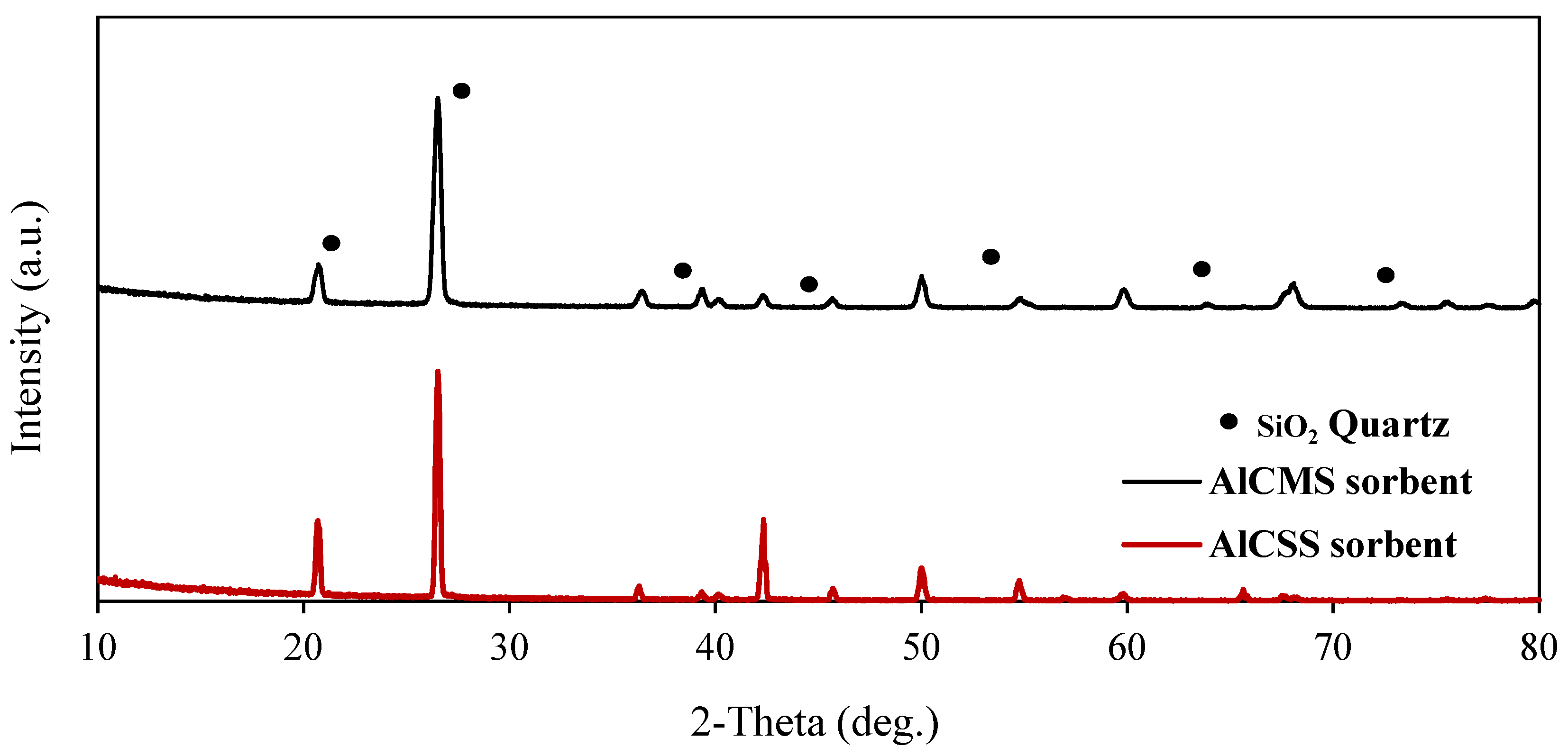
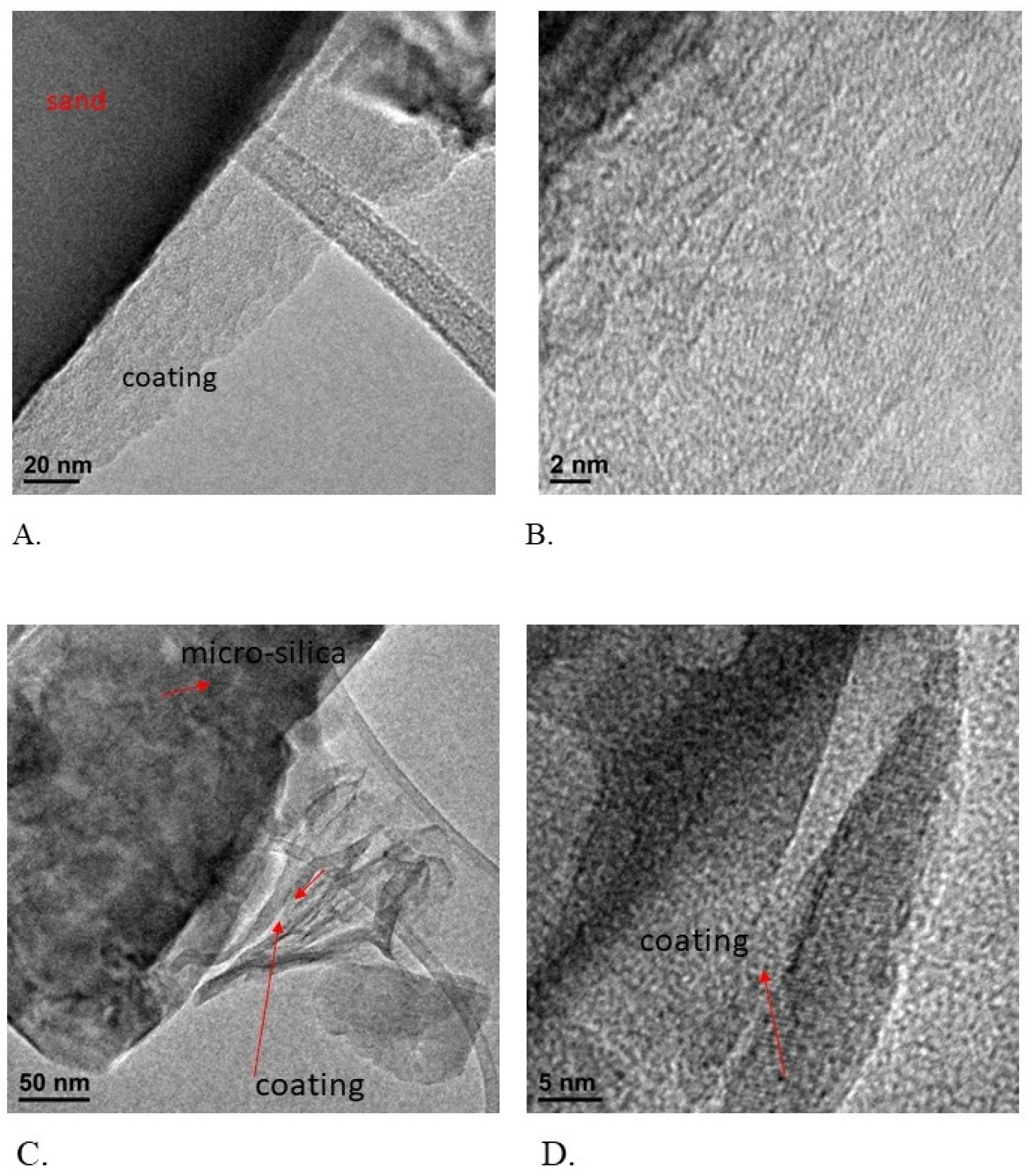
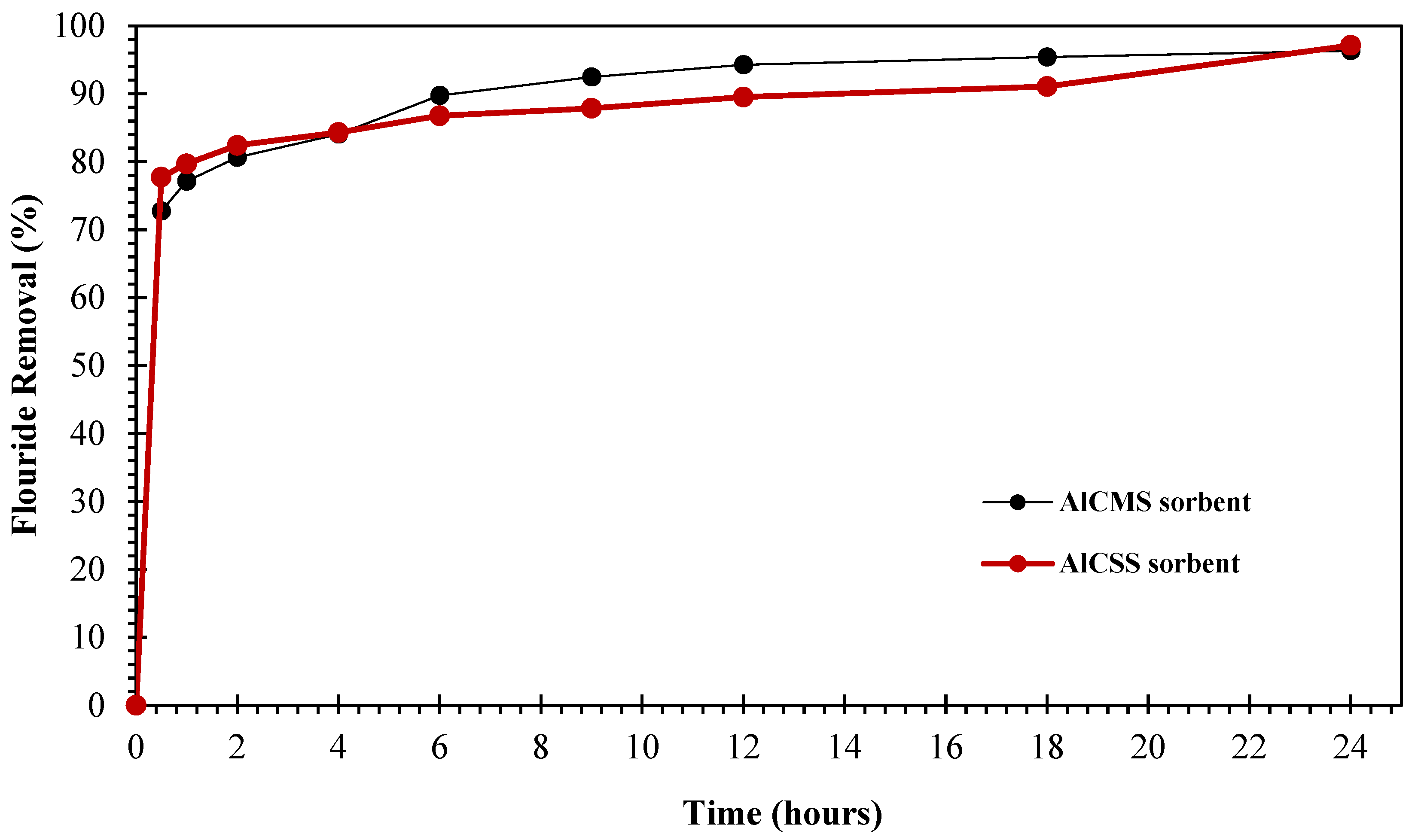
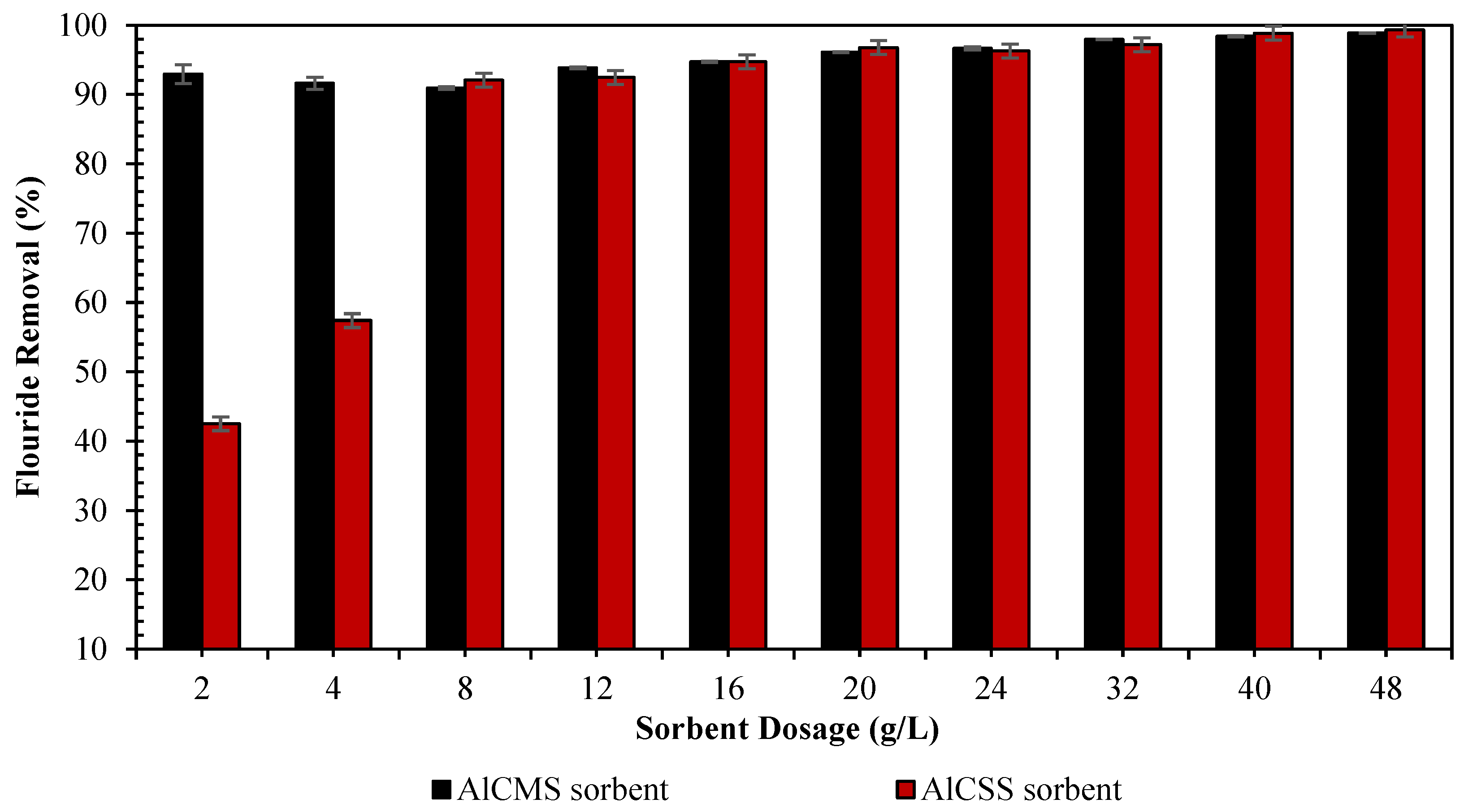
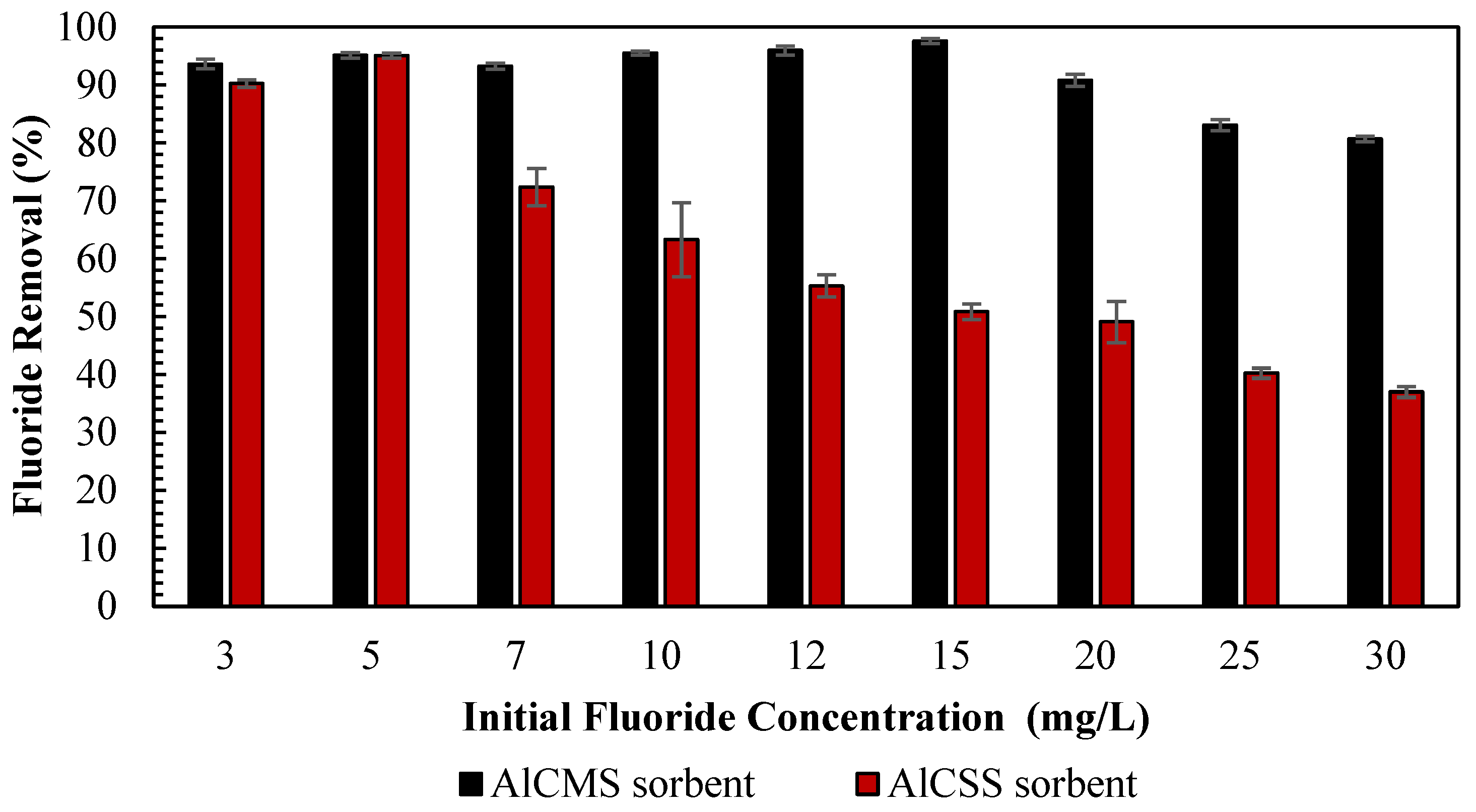

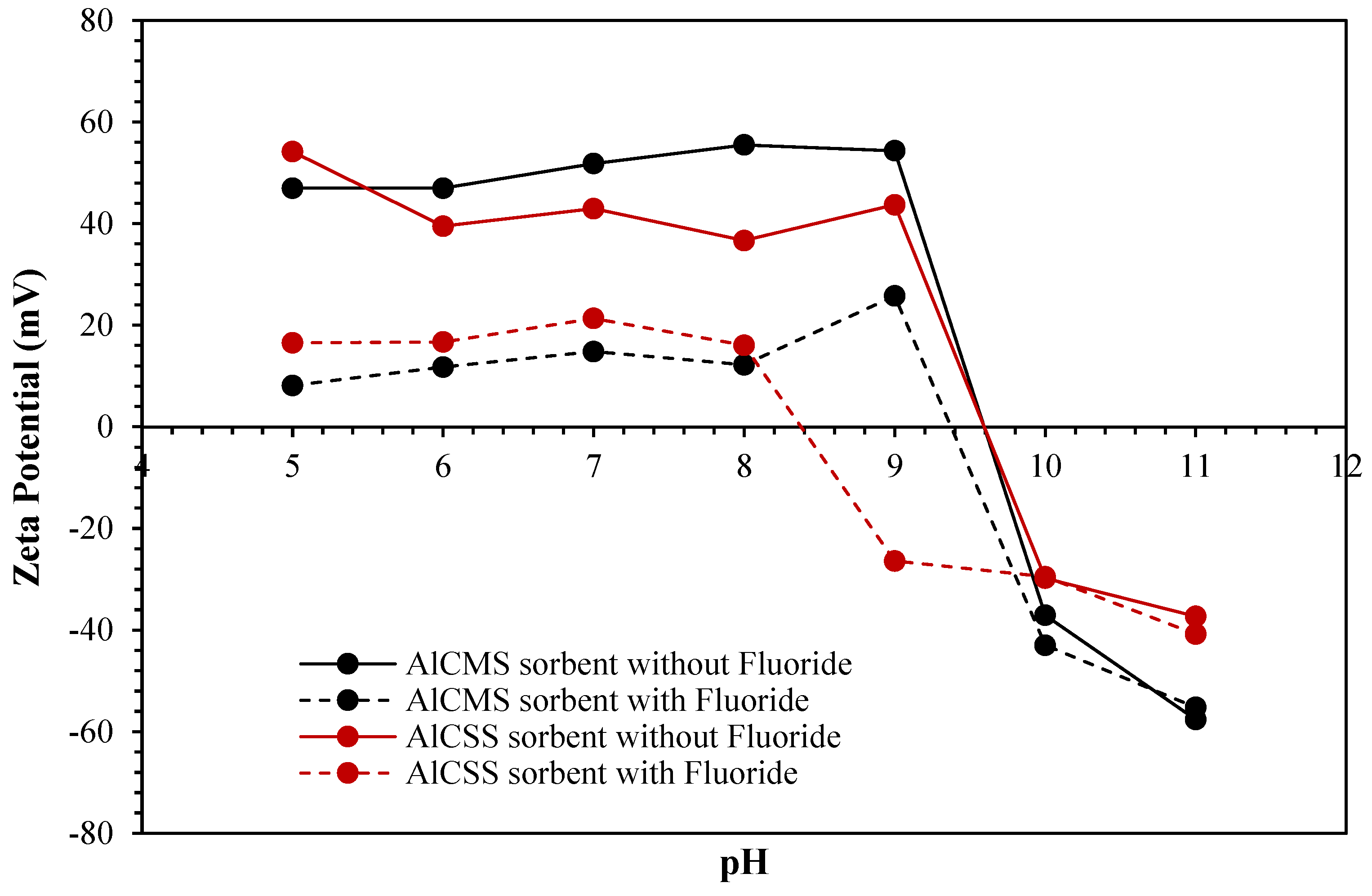
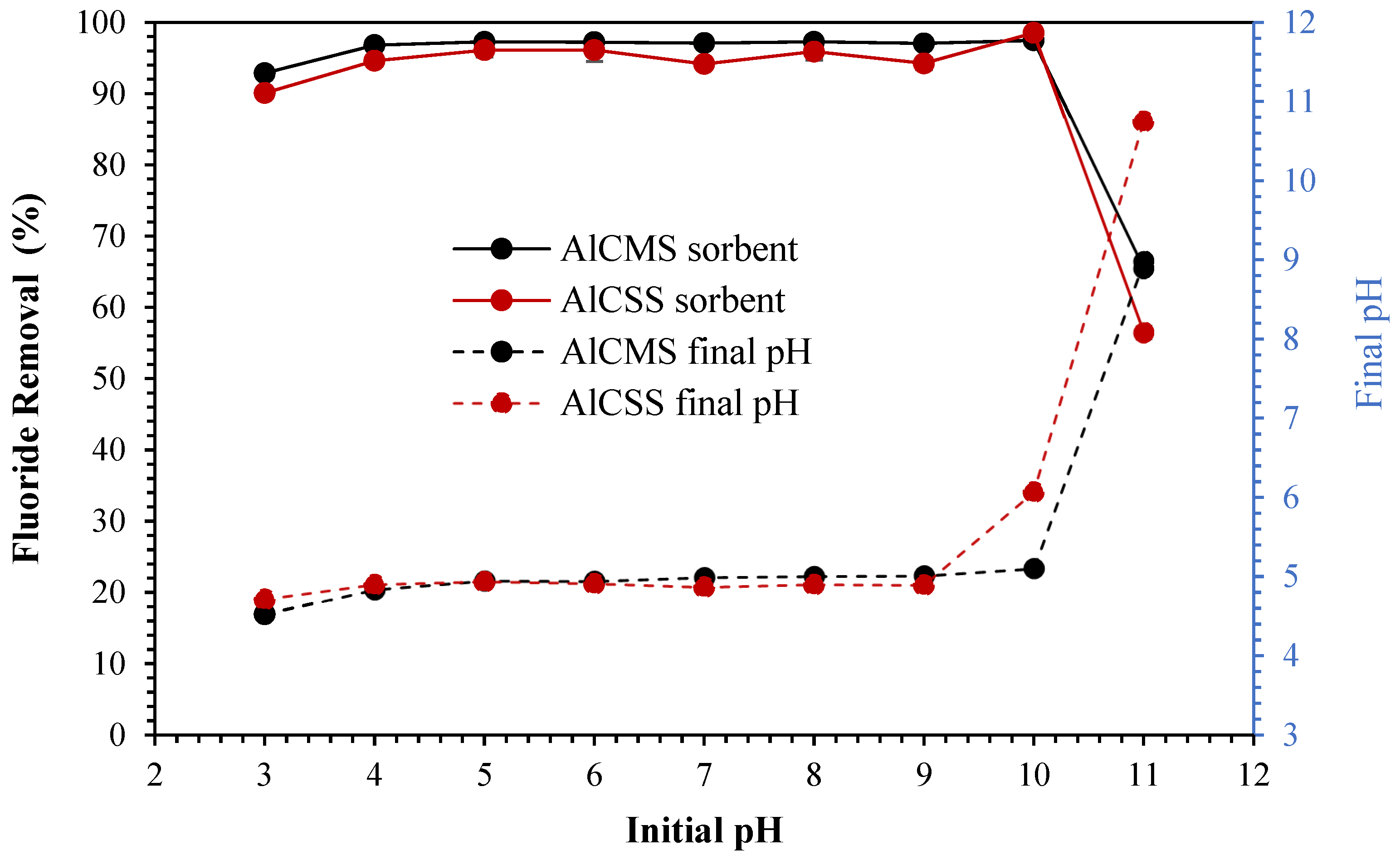
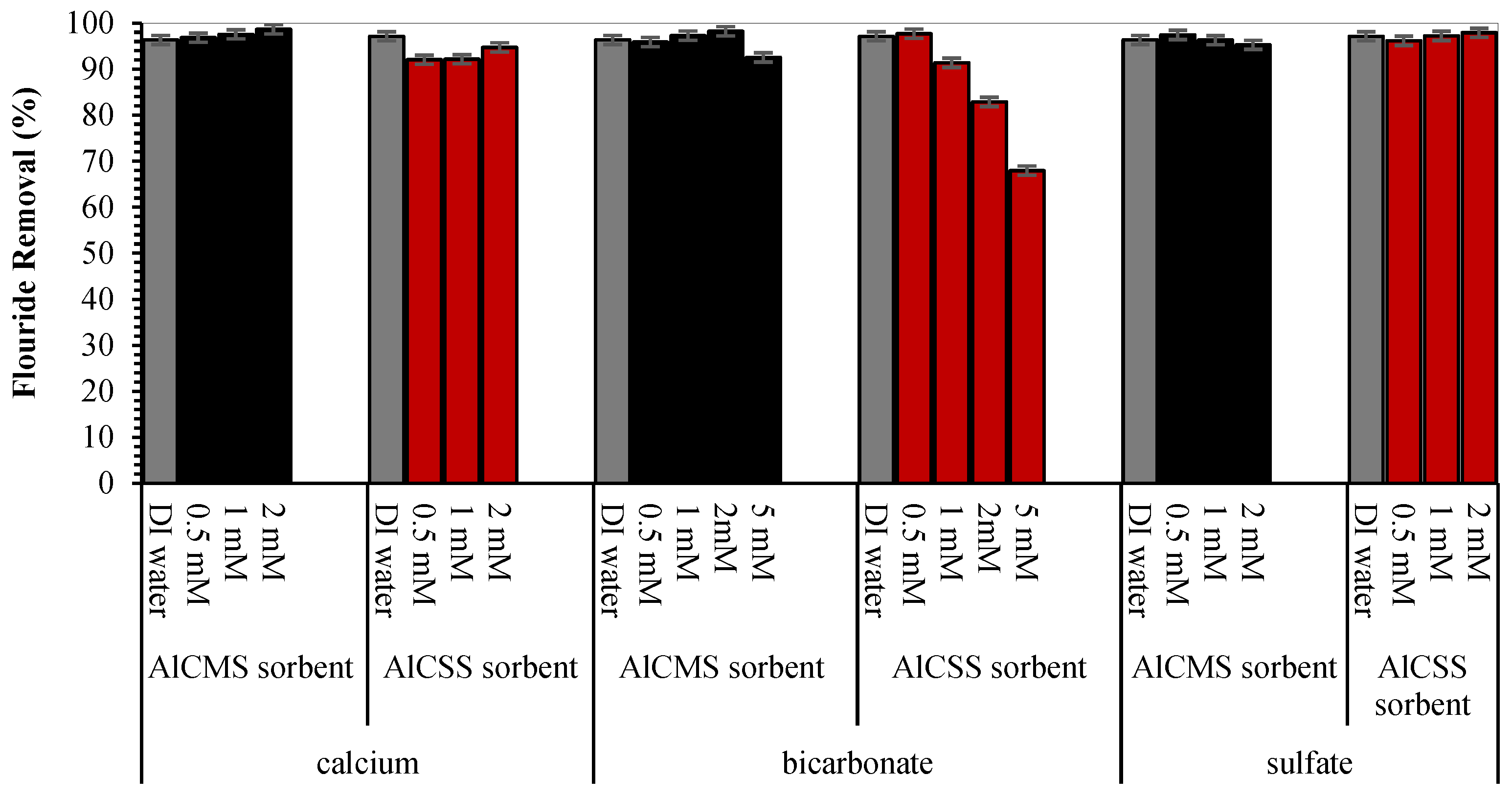

| Water Types | pH | TDS (mg/L) | Alkalinity (mg/L as CaCO3) | Total Hardness (mg/L as CaCO3) | Background Fluoride Concentration (mg/L) |
|---|---|---|---|---|---|
| Synthetic water | 7.99 | 340 | 125 | 100 | 0 |
| Tap water | 7.86 | 171 | 103 | 140 | 0.9 |
| Groundwater (type 1) | 8.47 | 303 | 202 | 273 | 0.7 |
| Groundwater (type 2) | 7.91 | 1220 | 150 | 796 | 0.3 |
| AlCSS Sorbent | AlCMS Sorbent | ||
|---|---|---|---|
| Experimental qe (mg/kg) | 242.8 | 240.9 | |
| Pseudo-first-order kinetics model | k1 (1/min) | 0.0033 | 0.0027 |
| qe (mg/kg) | 95.6 | 71.6 | |
| R2 | 0.7363 | 0.8791 | |
| Pseudo-second-order kinetics model | k2 (g/mg-min) | 0.1480 | 0.1688 |
| qe (mg/kg) | 238.1 | 243.9 | |
| R2 | 0.9975 | 0.9997 | |
| Intraparticle diffusion kinetics model | kid (mg/g-min1/2) | 3.806 | 4.208 |
| C | 125.80 | 120.16 | |
| R2 | 0.4533 | 0.5229 |
| Adsorbent | Langmuir | Freundlich | Dubinin–Radushkevich |
|---|---|---|---|
| AlCSSsorbent | qmL = 1430 mg/kg | 1/n = 0.2432 | KDR = 5.39 × 10−8 |
| KL = 0.50 L/mg | KF = 657 mg/kg | E = 3.05 kJ/mol | |
| R2 = 0.9694 | R2 = 0.8652 | R2 = 0.5738 | |
| AlCMSsorbent | qmL = 10,000 mg/kg | 1/n = 0.3153 | KDR =1.143 × 10−7 |
| KL = 0.333 L/mg | KF = 2948 mg/kg | E = 2.09 kJ/mol | |
| R2 = 0.9727 | R2 = 0.8663 | R2 = 0.8171 |
| Adsorbent | Adsorption Capacity (mg/kg) | BET Surface Area (m2/g) | Surface-Normalized Adsorption Capacity (µg/m2) |
|---|---|---|---|
| AlCSS sorbent | 1430 | 0.6285 | 2273 |
| AlCMS sorbent | 10,000 | 10.5021 | 952 |
Disclaimer/Publisher’s Note: The statements, opinions and data contained in all publications are solely those of the individual author(s) and contributor(s) and not of MDPI and/or the editor(s). MDPI and/or the editor(s) disclaim responsibility for any injury to people or property resulting from any ideas, methods, instructions or products referred to in the content. |
© 2024 by the authors. Licensee MDPI, Basel, Switzerland. This article is an open access article distributed under the terms and conditions of the Creative Commons Attribution (CC BY) license (https://creativecommons.org/licenses/by/4.0/).
Share and Cite
Modaresahmadi, K.; Khodadoust, A.P.; Wescott, J. Adsorption of Fluoride from Water Using Aluminum-Coated Silica Adsorbents: Comparison of Silica Sand and Microcrystalline Silica. Separations 2024, 11, 125. https://doi.org/10.3390/separations11040125
Modaresahmadi K, Khodadoust AP, Wescott J. Adsorption of Fluoride from Water Using Aluminum-Coated Silica Adsorbents: Comparison of Silica Sand and Microcrystalline Silica. Separations. 2024; 11(4):125. https://doi.org/10.3390/separations11040125
Chicago/Turabian StyleModaresahmadi, Kiana, Amid P. Khodadoust, and James Wescott. 2024. "Adsorption of Fluoride from Water Using Aluminum-Coated Silica Adsorbents: Comparison of Silica Sand and Microcrystalline Silica" Separations 11, no. 4: 125. https://doi.org/10.3390/separations11040125




